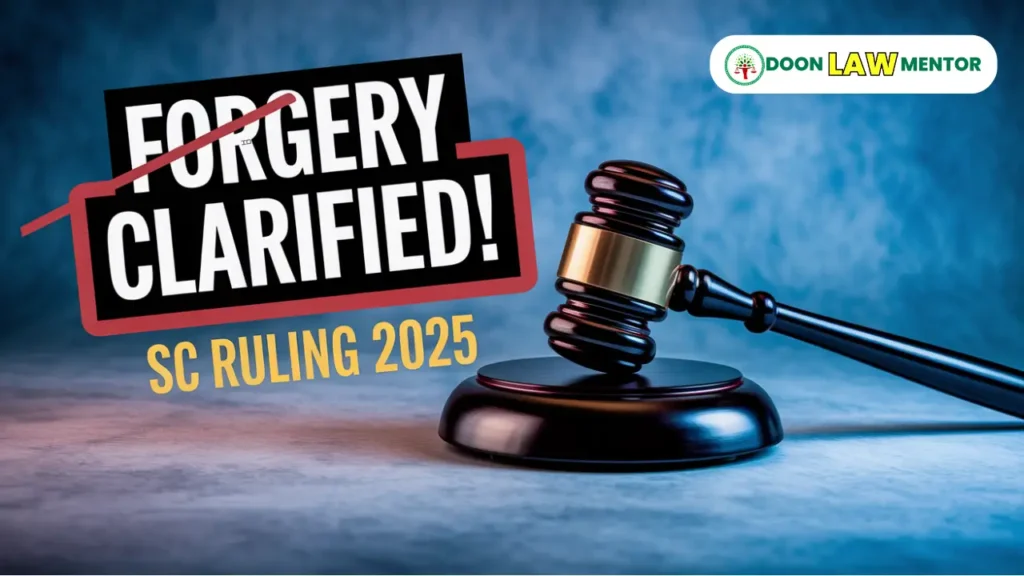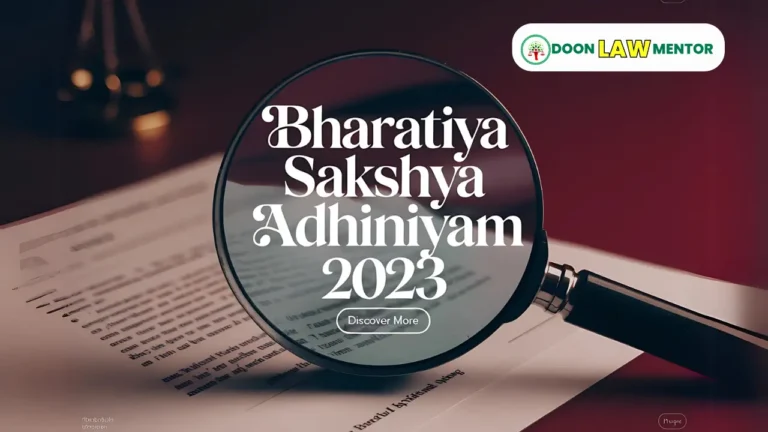In the case Ariaswamy v. State of Tamil Nadu, the Supreme Court clarified that Forgery Before Court Section 195 CrPC does not apply to pre-court forgery, allowing prosecution without court permission. This ruling ensures justice for forged documents. This blog explains the Forgery Before Court Section 195 CrPC verdict for Judiciary, APO, and JLO aspirants preparing for 2025 exams.
Table of Contents
Introduction
In a landmark ruling on August 1, 2024, the Supreme Court of India clarified the applicability of Forgery Before Court Section 195 CrPC in the case Ariaswamy v. State of Tamil Nadu. The Court ruled that Section 195(1)(b)(ii) of the Code of Criminal Procedure (CrPC) does not apply to forgery committed before a document is produced in court, meaning prosecution can proceed without court permission. This decision overturned a High Court order and provided clarity on a long-debated procedural issue, ensuring that pre-court forgery is treated as a general criminal offense.
The ruling has significant implications for criminal law and consumer protection. For Judiciary, APO, and JLO aspirants, the Forgery Before Court Section 195 CrPC verdict is a must-know for your 2025 exams, offering insights into criminal procedure and judicial oversight. This blog explains the case in simple language, covering all key points to help you prepare.
Read More: Wife Can Join Husband’s Defamation Suit : Supreme Court
What Is Section 195 CrPC and BNSS Section 215?
To understand the Forgery Before Court Section 195 CrPC ruling, let’s first look at the legal framework involved.
Section 195 CrPC Overview
Section 195 of the Code of Criminal Procedure (CrPC), 1973, sets rules for when courts can take cognizance of certain offenses. Cognizance means a court officially recognizing a case and starting proceedings. Section 195(1)(b)(ii) specifically deals with offenses like forgery of documents used as evidence in a judicial proceeding. It says:
- A court cannot take cognizance of such offenses unless a complaint is filed by the concerned court or an authorized officer.
- This rule applies to offenses under Sections 193 to 196, 199, 200, 205 to 211, and 228 of the Indian Penal Code (IPC), as well as Section 195, which includes forgery of documents produced in court.
The purpose of this section is to prevent misuse of the criminal justice system and protect the sanctity of judicial records by ensuring that only the court where the document was used can initiate prosecution.
BNSS Section 215 (2023 Replacement)
The CrPC has been replaced by the Bharatiya Nagarik Suraksha Sanhita (BNSS), 2023, which came into effect on July 1, 2024. Section 195 CrPC is now mirrored under Section 215 of the BNSS. Specifically:
- Section 215(1)(b)(ii) BNSS: Like Section 195(1)(b)(ii) CrPC, it restricts courts from taking cognizance of forgery-related offenses involving documents produced in judicial proceedings unless the court files a complaint.
The BNSS maintains the same intent as the CrPC—to safeguard judicial proceedings—but the Supreme Court’s ruling in this case applies to both the old CrPC and the new BNSS provisions, as the principle remains unchanged.
Key Issue: Timing of Forgery
A major question in this area of law is whether Section 195 CrPC (or Section 215 BNSS) applies to forgery committed before a document is produced in court, or only to forgery that happens during court proceedings. This distinction is crucial because it determines whether a private party can directly file a criminal complaint for forgery or if they need the court’s permission first. The Supreme Court’s ruling in Ariaswamy v. State of Tamil Nadu addresses this issue head-on.
Read More: 7 Daily Habits of Top Judiciary Exam Rankers in 2025: Secrets to Success
What Happened in Ariaswamy v. State of Tamil Nadu (2024)?
The Forgery Before Court Section 195 CrPC ruling arose from a property dispute involving a forged document. Let’s explore the case details.
The Forgery Incident
In 2008, the respondents in the case, led by S. Thangavel, created a forged unregistered sale agreement on stamp paper. This document falsely claimed that a property belonging to Ariaswamy (the appellant) had been sold to them. At the time the document was forged, no court litigation had started—the forgery was committed before any judicial proceedings. In 2011, the respondents filed a civil suit against Ariaswamy, using the forged sale agreement as evidence to support their claim over the property.
Discovery of the Forgery
During the civil suit, Ariaswamy discovered that the sale agreement was forged. He obtained expert evidence confirming the document’s falsity and filed a criminal complaint against the respondents in 2012. The complaint accused them of forgery under Section 467 IPC (forgery of valuable security), Section 471 IPC (using a forged document as genuine), and other related offenses. The police investigated and filed a chargesheet, leading to the trial court taking cognizance of the case.
High Court Quashes the Case
The respondents challenged the criminal proceedings in the Madras High Court, arguing that Section 195(1)(b)(ii) CrPC barred the trial court from taking cognizance without a complaint from the civil court where the forged document was produced. In 2016, the High Court quashed the criminal proceedings, agreeing with the respondents. It ruled that since the forged document was used as evidence in the civil suit, prosecution could only proceed if the civil court filed a complaint, as required by Section 195 CrPC. The High Court’s decision meant that Ariaswamy’s criminal complaint was invalid, effectively shielding the respondents from prosecution.
Appeal to the Supreme Court
Ariaswamy appealed to the Supreme Court in 2016 (Criminal Appeal No. 1419 of 2016), challenging the High Court’s order. He argued that Section 195 CrPC does not apply to forgery committed before a document is produced in court, and thus, his criminal complaint should stand. The Supreme Court, comprising Justices B.R. Gavai and K.V. Viswanathan, heard the case and delivered its verdict on August 1, 2024, overturning the High Court’s decision and providing clarity on the applicability of Section 195 CrPC.
What Did the Supreme Court Say?
The Supreme Court made several key observations in the Forgery Before Court Section 195 CrPC ruling, overturning the High Court’s decision. Let’s break down its findings.
Section 195 Applies Only to In-Court Forgery
The Court clarified that Section 195(1)(b)(ii) CrPC applies only when the forgery is committed after a document is produced in court as evidence. It said, “Section 195 applies only when the offense is committed after the document is produced in court.” In this case, the respondents forged the sale agreement in 2008, well before the civil suit began in 2011. The forgery was a pre-court act, meaning it occurred outside the judicial process. The Court held that such pre-court forgery is not covered by Section 195 CrPC, and thus, no court permission is needed to prosecute the offenders.
Pre-Court Forgery Is a General Criminal Offense
The Court ruled that forgery committed before court proceedings is a general criminal offense under the Indian Penal Code (IPC), such as Sections 467 and 471 IPC, and can be prosecuted like any other crime. It stated, “If the forgery was committed prior to court proceedings, then Section 195 CrPC does not bar prosecution.” The Court explained that pre-court forgery does not involve an abuse of the court process, which is what Section 195 is meant to address. Instead, it is a standalone criminal act that can be pursued through a regular criminal complaint, as Ariaswamy did.
Court Permission Not Needed for Pre-Court Forgery
The Court explicitly held that no court permission is required to prosecute pre-court forgeries. It said, “Court permission is not needed for prosecuting pre-court forgeries.” This overturned the High Court’s ruling, which had incorrectly applied Section 195 to block Ariaswamy’s complaint. The Court emphasized that requiring court permission in such cases would shield offenders and deny justice to victims of forgery, especially in property disputes where forged documents are commonly used.
Distinction Between Pre-Court and In-Court Forgery
The Court provided a clear distinction between pre-court and in-court forgery:
- Before Submission to Court: If a document is forged before it is produced in court, it is a general criminal offense (e.g., under Sections 467 and 471 IPC). Anyone can file a criminal complaint, and the court can take cognizance without a complaint from the court where the document was later used.
- After Submission as Evidence in Court: If a document is tampered with or fabricated after being produced in court, it is considered an abuse of the court process. In such cases, Section 195 CrPC applies, and only the court where the document was produced can file a complaint for prosecution.
The Court said, “Only in-court document tampering or fabrication requires court complaint under Section 195.” This distinction ensures that pre-court forgeries are not shielded by procedural technicalities.
Rationale Behind the Ruling
The Court’s rationale was rooted in the purpose of Section 195 CrPC. It explained that the section is meant to protect the integrity of judicial proceedings by ensuring that offenses like in-court forgery are prosecuted only with the court’s involvement. However, pre-court forgery does not directly affect the court process—it is a separate criminal act that harms individuals, not the judiciary. The Court said, “Pre-court forgery is a general criminal offense, not an abuse of court proceedings.” Allowing prosecution without court permission in such cases ensures that offenders are held accountable and victims can seek justice.
Final Decision
The Supreme Court set aside the Madras High Court’s order quashing the criminal proceedings against the respondents. It held that the trial court was correct to take cognizance of Ariaswamy’s complaint, as Section 195 CrPC did not apply to the pre-court forgery in this case. The Court directed the criminal proceedings to continue, allowing the prosecution of the respondents for forgery under the IPC. This decision reinstated Ariaswamy’s right to seek justice for the forged sale agreement.
What Does This Ruling Mean?
The Forgery Before Court Section 195 CrPC ruling has significant implications for criminal law, victim rights, and procedural clarity in India. Let’s break down its meaning in simple terms.
Good Points of the Ruling
- Ensures Justice for Victims: The ruling allows victims of pre-court forgery to seek justice without procedural hurdles. Ariaswamy could pursue his complaint against the respondents, ensuring they face prosecution for the forged sale agreement.
- Clarifies Legal Boundaries: The Court provided a clear distinction between pre-court and in-court forgery, resolving a long-standing ambiguity in applying Section 195 CrPC. This clarity helps lower courts handle similar cases correctly.
- Prevents Misuse of Section 195: The ruling stops offenders from using Section 195 as a shield to escape prosecution for pre-court forgeries, ensuring that procedural laws are not misused to protect wrongdoers.
- Supports Public Interest: By allowing prosecution of pre-court forgeries, the ruling protects public interest, especially in property disputes where forged documents are common, ensuring that such crimes are not overlooked.
Things to Think About
- Will Lower Courts Follow? While the Supreme Court clarified the law, some lower courts might still misapply Section 195 CrPC in pre-court forgery cases. Training might be needed to ensure consistent application.
- What About Complex Cases? In cases where forgery starts before court but continues during proceedings, determining when Section 195 applies might be tricky. Future rulings might need to address this.
- Impact on Court Workload? Allowing direct prosecution of pre-court forgeries might increase the number of criminal complaints, adding to the workload of trial courts already dealing with case backlogs.
- Need for Awareness? Litigants and lawyers might not be aware of this distinction, leading to delays in filing complaints. Public legal education might help ensure victims use this ruling effectively.
Why This Matters
The Forgery Before Court Section 195 CrPC ruling ensures that pre-court forgeries are treated as serious crimes, allowing victims to seek justice without unnecessary procedural barriers. It clarifies the scope of Section 195 CrPC and its BNSS equivalent, ensuring that procedural laws protect the judicial process without shielding offenders. The ruling also empowers litigants to address forgery in disputes, especially in property cases, promoting fairness and accountability. Aspirants should learn this because it highlights the judiciary’s role in balancing procedural safeguards with access to justice.
Why This Matters for Judiciary, APO, and JLO Aspirants
The Forgery Before Court Section 195 CrPC ruling is crucial for your 2025 exams. For Prelims, learn the case name Ariaswamy v. State of Tamil Nadu (2024), Section 195 CrPC, BNSS Section 215, and IPC Sections 467 and 471. For Mains, write essays on the applicability of Section 195 CrPC, pre-court forgery prosecution, or judicial oversight in criminal law, using this case. For Interviews, talk about how this ruling ensures justice for forgery victims while protecting court processes.
Conclusion
The Forgery Before Court Section 195 CrPC ruling in Ariaswamy v. State of Tamil Nadu (2024) is a landmark decision by the Supreme Court that resolves a critical procedural ambiguity in criminal law. The Court clarified that Section 195(1)(b)(ii) CrPC (now Section 215 BNSS) does not apply to forgery committed before a document is produced in court, allowing prosecution without court permission. In this case, a forged sale agreement created before a civil suit was not covered by Section 195, enabling Ariaswamy to pursue a criminal complaint against the respondents for forgery.
The ruling distinguishes between pre-court and in-court forgery, ensuring that pre-court acts are treated as general criminal offenses under the IPC. For Judiciary, APO, and JLO aspirants, this case is very important for your 2025 exams. It teaches you about criminal procedure, the scope of Section 195 CrPC, and the judiciary’s role in ensuring justice. Study the Forgery Before Court Section 195 CrPC ruling to do well in your exams. Start preparing with this case today to reach your goals in 2025!
#ForgeryBeforeCourtSection195CrPC, #AriaswamyvStateofTamilNadu2024, #SupremeCourtForgery, #JudiciaryExams #doonlawmentor









